HONDA ODYSSEY 1997 Owners Manual
Manufacturer: HONDA, Model Year: 1997, Model line: ODYSSEY, Model: HONDA ODYSSEY 1997Pages: 241, PDF Size: 2.52 MB
Page 181 of 241
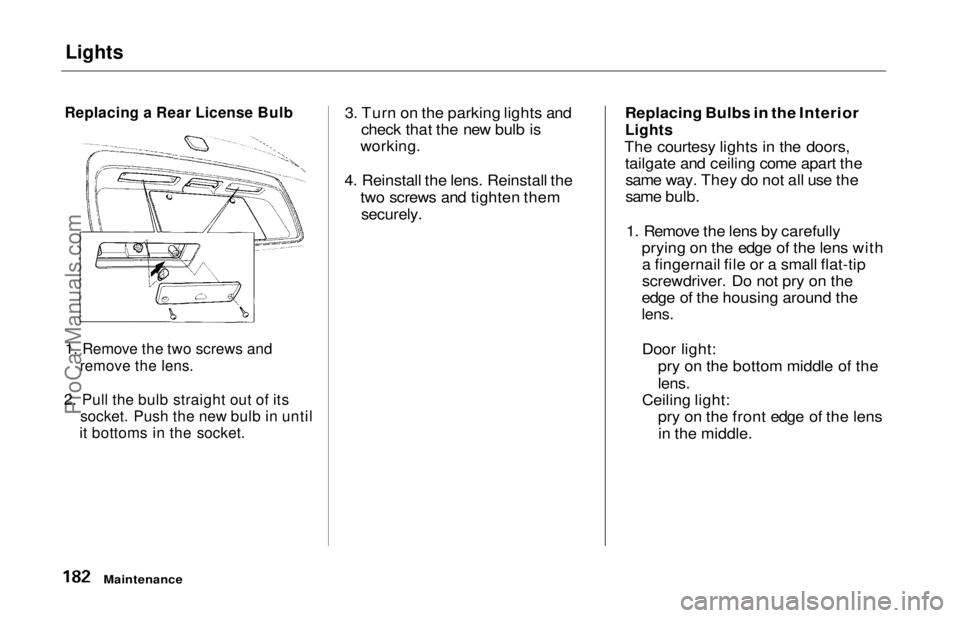
Lights
Replacing a Rear License Bulb
1. Remove the two screws and
remove the lens.
2. Pull the bulb straight out of its
socket. Push the new bulb in until
it bottoms in the socket.
3. Turn on the parking lights and
check that the new bulb is
working.
4. Reinstall the lens. Reinstall the two screws and tighten them
securely.
Replacing Bulbs in the Interior
Lights
The courtesy lights in the doors, tailgate and ceiling come apart thesame way. They do not all use the
same bulb.
1. Remove the lens by carefully prying on the edge of the lens witha fingernail file or a small flat-tip
screwdriver. Do not pry on the
edge of the housing around the
lens.
Door light: pry on the bottom middle of the
lens.
Ceiling light: pry on the front edge of the lens
in the middle.
MaintenanceProCarManuals.comMain Menu Table of Contents s t
Page 182 of 241
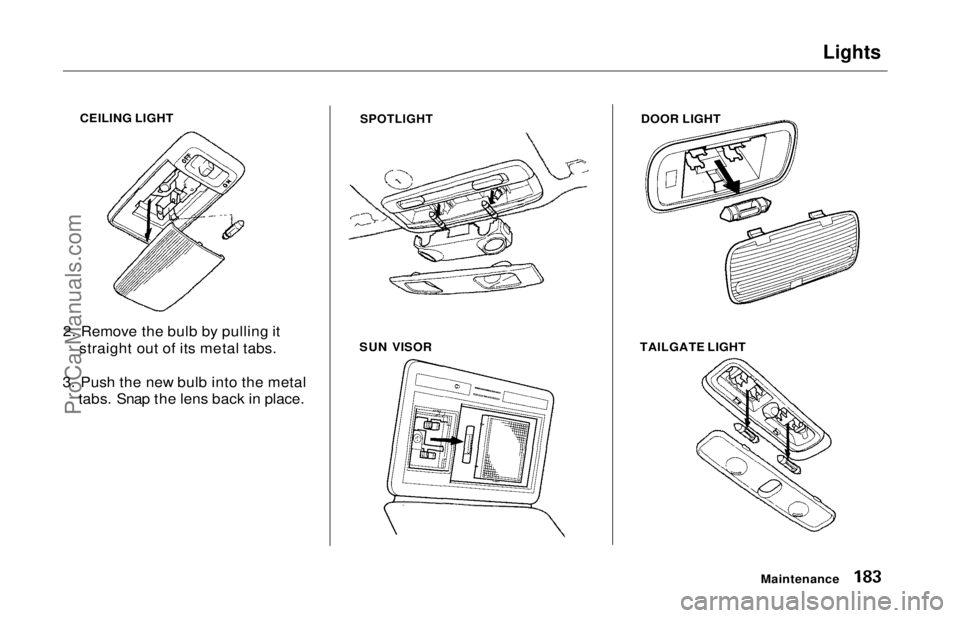
Lights
CEILING LIGHT
2. Remove the bulb by pulling it straight out of its metal tabs.
3. Push the new bulb into the metal tabs. Snap the lens back in place.
SPOTLIGHT
SUN VISOR DOOR LIGHT
TAILGATE LIGHT
MaintenanceProCarManuals.comMain Menu Table of Contents s t
Page 183 of 241
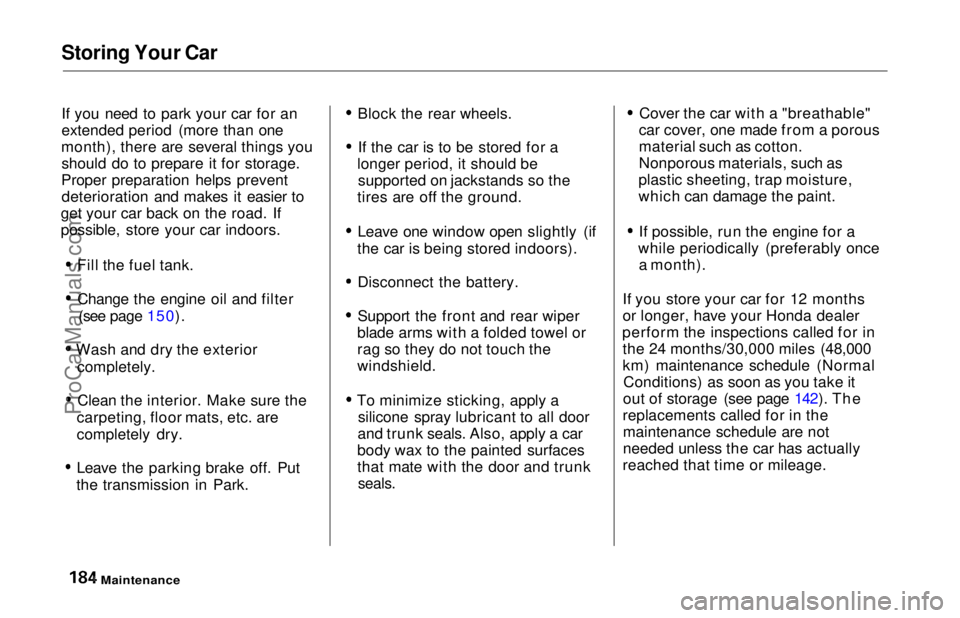
Storing Your Car
If you need to park your car for an
extended period (more than one
month), there are several things you should do to prepare it for storage.
Proper preparation helps prevent deterioration and makes it easier to
get your car back on the road. If
possible, store your car indoors.
Fill the fuel tank.Change the engine oil and filter (see page 150).
Wash and dry the exterior completely.
Clean the interior. Make sure the
carpeting, floor mats, etc. are
completely dry.
Leave the parking brake off. Put
the transmission in Park. Block the rear wheels.
If the car is to be stored for a
longer period, it should be supported on jackstands so the
tires are off the ground.
Leave one window open slightly (if
the car is being stored indoors).
Disconnect the battery.
Support the front and rear wiper
blade arms with a folded towel or
rag so they do not touch the
windshield.
To minimize sticking, apply a silicone spray lubricant to all door
and trunk seals. Also, apply a car
body wax to the painted surfaces
that mate with the door and trunk
seals.
Cover the car with a "breathable"
car cover, one made from a porous
material such as cotton.
Nonporous materials, such as
plastic sheeting, trap moisture,
which can damage the paint.
If possible, run the engine for a
while periodically (preferably once a month).
If you store your car for 12 months
or longer, have your Honda dealer
perform the inspections called for in the 24 months/30,000 miles (48,000
km) maintenance schedule (Normal Conditions) as soon as you take it
out of storage (see page 142). The
replacements called for in the maintenance schedule are not
needed unless the car has actually
reached that time or mileage.
MaintenanceProCarManuals.comMain Menu Table of Contents s t
Page 184 of 241

Appearance Care
Regular cleaning and polishing of
your Honda helps to keep it "new"
looking. This section gives you hints on how to clean your car and
preserve its appearance: the paint,
brightwork, wheels and interior. Also included are several things you cando to help prevent corrosion. Exterior Care.................................. 186
Washing...................................... 186
Waxing........................................187
Aluminum Wheels..................... 187Paint Touch-up........................... 187
Interior Care................................... 188 Carpeting.................................... 188
Fabric.......................................... 188
Vinyl............................................ 188
Seat Belts.................................... 189
Windows..................................... 189
Air Fresheners........................... 189
Corrosion Protection..................... 190
Body Repairs.................................. 191
Appearance CareProCarManuals.comMain Menu s t
Page 185 of 241
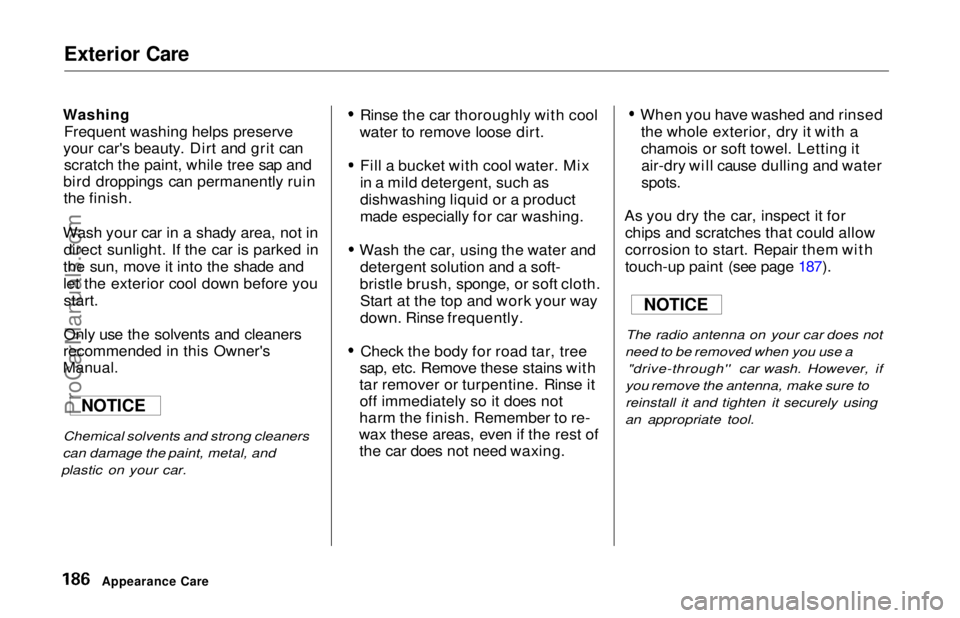
Exterior Care
Washing
Frequent washing helps preserve
your car's beauty. Dirt and grit can scratch the paint, while tree sap and
bird droppings can permanently ruin the finish.
Wash your car in a shady area, not in direct sunlight. If the car is parked in
the sun, move it into the shade and
let the exterior cool down before you start.
Only use the solvents and cleaners
recommended in this Owner's
Manual.
Chemical solvents and strong cleaners
can damage the paint, metal, and
plastic on your car.
Rinse the car thoroughly with cool
water to remove loose dirt.
Fill a bucket with cool water. Mix
in a mild detergent, such as
dishwashing liquid or a product
made especially for car washing.
Wash the car, using the water and detergent solution and a soft-
bristle brush, sponge, or soft cloth. Start at the top and work your way
down. Rinse frequently.
Check the body for road tar, tree
sap, etc. Remove these stains with
tar remover or turpentine. Rinse it off immediately so it does not
harm the finish. Remember to re-
wax these areas, even if the rest of the car does not need waxing. When you have washed and rinsed
the whole exterior, dry it with a
chamois or soft towel. Letting itair-dry will cause dulling and water
spots.
As you dry the car, inspect it for chips and scratches that could allow
corrosion to start. Repair them with
touch-up paint (see page 187).
The radio antenna on your car does not
need to be removed when you use a "drive-through'' car wash. However, if
you remove the antenna, make sure to
reinstall it and tighten it securely using
an appropriate tool.
Appearance Care
NOTICE
NOTICEProCarManuals.comMain Menu Table of Contents s t
Page 186 of 241

Exterior Care
Waxing Always wash and dry the whole car before waxing it. You should wax
your car, including the metal trim,
whenever water sits on the surface in large patches. It should form into
beads or droplets after waxing.
You should use a quality liquid or paste wax. Apply it according to the
instructions on the container. In
general, there are two types of
products:
Waxes — A wax coats the finish and protects it from damage by exposure
to sunlight, air pollution, etc. You should use a wax on your Honda
when it is new.
Polishes — Polishes and cleaner/
waxes can restore the shine to paint that has oxidized and lost some of itsshine. They normally contain mild
abrasives and solvents that remove
the top layer of the finish. You should use a polish on your Honda if
the finish does not have its original shine after using a wax.
Cleaning tar, insects, etc. with
removers also takes off the wax.
Remember to re-wax those areas,
even if the rest of the car does not
need waxing.
Aluminum Wheels
On some models
Clean your Honda's aluminum alloy
wheels as you do the rest of the exterior. Wash them with the same
solution, and rinse them thoroughly.
The wheels have a protective clear- coat that keeps the aluminum from
corroding and tarnishing. Using
harsh chemicals, including some commercial wheel cleaners, or stiff
brushes can damage this clear-coat. Only use a mild detergent and soft
brush or sponge to clean the wheels.
Paint Touch-up
Your dealer has touch-up paint to match your car's color. The color
code is printed on a sticker on thedriver's doorjamb. Take this code to
your dealer so you are sure to get the correct color.
Inspect your car frequently for chipsor scratches in the paint. Repair
them right away to prevent corrosion of the metal underneath. Use the
touch-up paint only on small chips and scratches. More extensive paint
damage should be repaired by a
professional.
Appearance CareProCarManuals.comMain Menu Table of Contents s t
Page 187 of 241
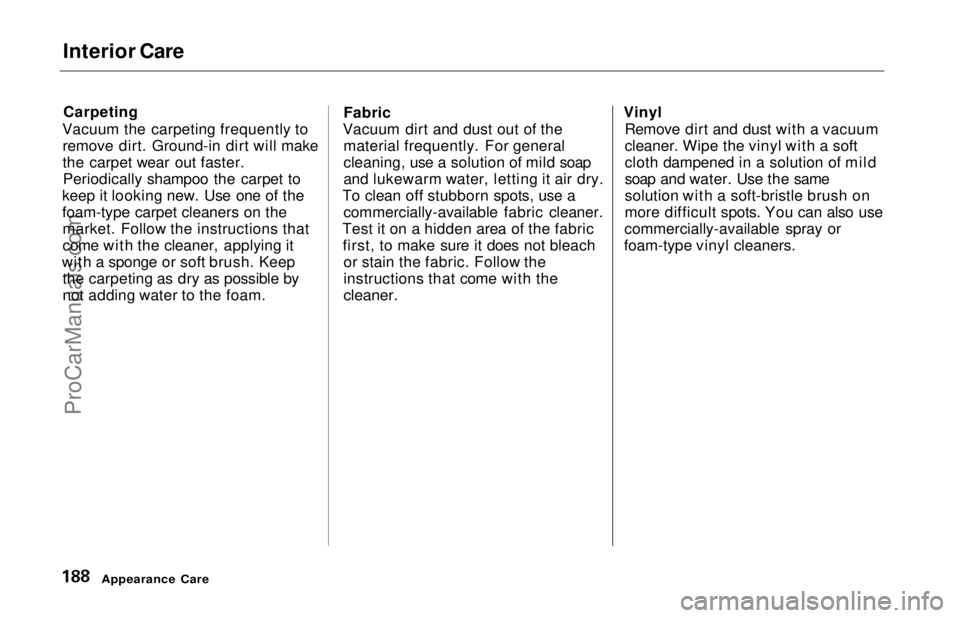
Interior Care
Carpeting
Vacuum the carpeting frequently to remove dirt. Ground-in dirt will make
the carpet wear out faster.Periodically shampoo the carpet to
keep it looking new. Use one of the
foam-type carpet cleaners on the market. Follow the instructions that
come with the cleaner, applying it
with a sponge or soft brush. Keep the carpeting as dry as possible by
not adding water to the foam. Fabric
Vacuum dirt and dust out of the material frequently. For general
cleaning, use a solution of mild soap
and lukewarm water, letting it air dry.
To clean off stubborn spots, use a commercially-available fabric cleaner.
Test it on a hidden area of the fabric first, to make sure it does not bleach or stain the fabric. Follow the
instructions that come with the
cleaner.
Vinyl
Remove dirt and dust with a vacuum
cleaner. Wipe the vinyl with a soft
cloth dampened in a solution of mild
soap and water. Use the same
solution with a soft-bristle brush on
more difficult spots. You can also use
commercially-available spray or
foam-type vinyl cleaners.
Appearance CareProCarManuals.comMain Menu Table of Contents s t
Page 188 of 241
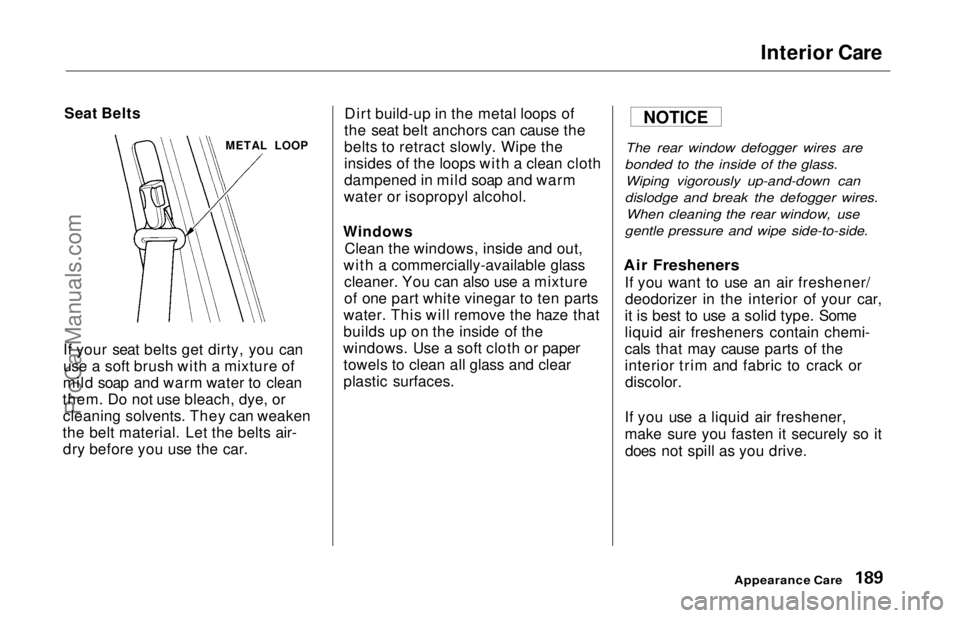
Interior Care
Seat Belts
If your seat belts get dirty, you can
use a soft brush with a mixture of
mild soap and warm water to clean
them. Do not use bleach, dye, or cleaning solvents. They can weaken
the belt material. Let the belts air- dry before you use the car. Dirt build-up in the metal loops of
the seat belt anchors can cause the
belts to retract slowly. Wipe the
insides of the loops with a clean cloth
dampened in mild soap and warm
water or isopropyl alcohol.
Windows Clean the windows, inside and out,
with a commercially-available glass cleaner. You can also use a mixture
of one part white vinegar to ten parts
water. This will remove the haze that
builds up on the inside of the
windows. Use a soft cloth or paper towels to clean all glass and clear
plastic surfaces.
The rear window defogger wires are
bonded to the inside of the glass. Wiping vigorously up-and-down can
dislodge and break the defogger wires. When cleaning the rear window, use
gentle pressure and wipe side-to-side.
Air Fresheners
If you want to use an air freshener/deodorizer in the interior of your car,
it is best to use a solid type. Some
liquid air fresheners contain chemi-
cals that may cause parts of the
interior trim and fabric to crack or discolor.
If you use a liquid air freshener,
make sure you fasten it securely so it does not spill as you drive.
Appearance Care
METAL LOOP
NOTICEProCarManuals.comMain Menu Table of Contents s t
Page 189 of 241
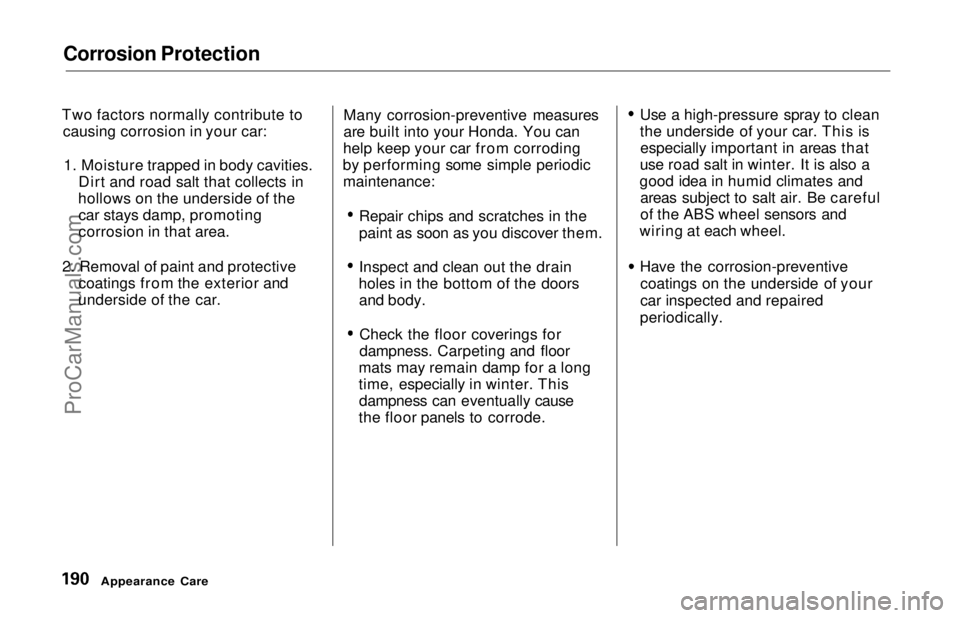
Corrosion Protection
Two factors normally contribute to causing corrosion in your car:
1. Moisture trapped in body cavities. Dirt and road salt that collects in
hollows on the underside of the car stays damp, promoting
corrosion in that area.
2. Removal of paint and protective coatings from the exterior and
underside of the car. Many corrosion-preventive measures
are built into your Honda. You can
help keep your car from corroding
by performing some simple periodic
maintenance:
Repair chips and scratches in the
paint as soon as you discover them.
Inspect and clean out the drain
holes in the bottom of the doors and body.
Check the floor coverings for
dampness. Carpeting and floor
mats may remain damp for a long
time, especially in winter. This dampness can eventually cause
the floor panels to corrode. Use a high-pressure spray to clean
the underside of your car. This is
especially important in areas that
use road salt in winter. It is also a
good idea in humid climates and areas subject to salt air. Be careful
of the ABS wheel sensors and
wiring at each wheel.
Have the corrosion-preventivecoatings on the underside of your
car inspected and repaired
periodically.
Appearance CareProCarManuals.comMain Menu Table of Contents s t
Page 190 of 241

Body Repairs
Body repairs can affect your car's
resistance to corrosion. If your car
needs repairs after a collision, pay
close attention to the parts used in
the repair and the quality of the
work.
Make sure the repair facility usesGenuine Honda replacement body
parts. Some companies make sheet
metal pieces that seem to duplicate
the original Honda body parts, but are actually inferior in fit, finish, and
corrosion resistance. Once installed,
they do not give the same high- quality appearance. When reporting your collision to the
insurance company, tell them you
want Genuine Honda parts used in
the repair. Although most insurers
recognize the quality of original parts, some may try to specify that
the repairs be done with other
available parts. You should investi-
gate this before any repairs are
begun.
Take your car to your authorized Honda dealer for inspection after the
repairs are completed. He can make sure that quality materials were used,
and that corrosion-preventive
coatings were applied to all repaired
and replaced parts.
Appearance CareProCarManuals.comMain Menu Table of Contents s t